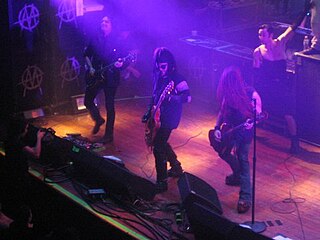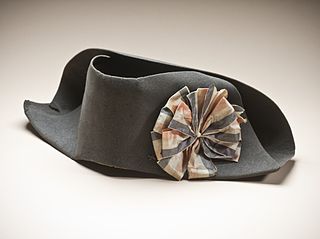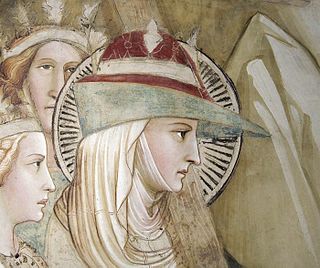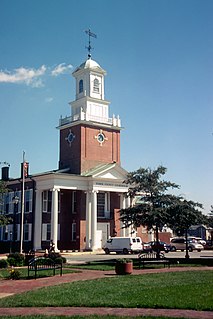
John Robert "Joe" Cocker was an English singer. He was known for his gritty voice, spasmodic body movement in performance, and distinctive versions of popular songs of varying genres.

A leprechaun is a type of fairy of the Aos Sí in Irish folklore. They are usually depicted as little bearded men, wearing a coat and hat, who partake in mischief. They are solitary creatures who spend their time making and mending shoes and have a hidden pot of gold at the end of the rainbow. If captured by a human, they often grant three wishes in exchange for their freedom. Like other Irish fairies, leprechauns may be derived from the Tuatha Dé Danann. Leprechaun-like creatures rarely appear in Irish mythology and only became prominent in later folklore.

Revolting Cocks, also known as RevCo, are an American–Belgian industrial rock band and, sometimes, supergroup that began as a musical side-project for Richard 23 of Front 242, Luc van Acker, and Al Jourgensen of Ministry.
Position fixing or positioning is the branch of navigation concerned with the use of a variety of visual and electronic methods to determine the position of a vehicle or person on the surface of the Earth.

The flag of Delaware consists of a buff-colored diamond on a field of colonial blue, with the coat of arms of the state of Delaware inside the diamond. Below the diamond, the date December 7, 1787, declares the day on which Delaware became the first state to ratify the United States Constitution. The colors of the flag reflect the colors of the uniform of General George Washington.

The tricorne or tricorn is a style of hat that was popular during the 18th century, falling out of style by 1800, though actually not called a "tricorne" until the mid-19th century. During the 18th century, hats of this general style were referred to as "cocked hats". At the peak of its popularity, the tricorne varied greatly in style and size, and was worn not only by the aristocracy, but also as common civilian dress, and as part of military and naval uniforms. Typically made from animal fiber, the more expensive being of beaver-hair felt and the less expensive of wool felt, the hat's most distinguishing characteristic was that three sides of the brim were turned up (cocked) and either pinned, laced, or buttoned in place to form a triangle around the crown. The style served two purposes: first, it allowed stylish gentlemen to show off the most current fashions of their wigs, and thus their social status; and secondly, the cocked hat, with its folded brim, was much smaller than other hats and therefore could be more easily tucked under an arm when going inside a building, where social etiquette dictated that a gentleman should remove his hat. Tricornes with laced sides could have the laces loosened and the sides dropped down to provide better protection from the weather, sun, and rain.

The bicorne or bicorn is a historical form of hat widely adopted in the 1790s as an item of uniform by European and American military and naval officers. It is now most readily associated with Napoléon Bonaparte but in practice most generals and staff officers of the Napoleonic period wore bicornes, and it survived as a widely worn full-dress headdress until at least 1914.

Court uniform and dress were required to be worn by those in attendance at the royal Court in the nineteenth and twentieth centuries.

A bycocket or bycoket is a style of hat that was fashionable for both men and women in Western Europe from the 13th to the 16th century. It has a wide brim that is turned up in the back and pointed in the front like a bird's beak. In French, it is called a chapeau à bec due to this resemblance.

Chapeau is a French term signifying a hat or other covering for the head.

A beaver hat is a hat made from felted beaver fur. They were fashionable across much of Europe during the period 1550–1850 because the soft yet resilient material could be easily combed to make a variety of hat shapes. Smaller hats made of beaver were sometimes called beaverkins, as in Thomas Carlyle's description of his wife as a child.
The Cocked Hat Stakes is a Listed flat horse race in Great Britain open to three-year-old colts and geldings. It is run at Goodwood over a distance of 1 mile 3 furlongs and 44 yards, and it is scheduled to take place each year in May.

A cavalier hat is a variety of wide-brimmed hat popular in the seventeenth century. These hats were often made from felt, and usually trimmed with an ostrich plume. They were often cocked up or had one side of the brim pinned to the side of the crown of the hat which was then decorated with feathers.

Cocker is the tenth studio album by Joe Cocker, released in April 1986, his second on Capitol label. It features hit singles "You Can Leave Your Hat On" and "Don't You Love Me Anymore", the first made popular after its use in the famous striptease scene in the film 9 1/2 Weeks. Released as a single, Cocker's version of the song peaked at No. 35 on Billboard Hot Mainstream Rock Tracks. The album also features rendition of Marvin Gaye's "Inner City Blues", a Motown legend's classic lament to urban decay.
Cocked Hat Island, located off the eastern coast of Ellesmere Island, is a part of the Qikiqtaaluk Region of the Canadian territory of Nunavut. The island is located within the Canadian Arctic Archipelago, and is a part of the Queen Elizabeth Islands.
"You Can Leave Your Hat On" is a song written by Randy Newman and appearing on his 1972 album Sail Away.
The sombrero calañés or sombrero de Calañas is a traditional hat made in the municipality of Calañas, province of Huelva, autonomous community of Andalusia, Spain. It is also sometimes called the sombrero castoreño because it is traditionally made from the felt of a beaver (castor) or similar animal.
Who Killed Cock Robin is a Silly Symphonies short released on June 26, 1935 by United Artists, produced by Walt Disney and directed by David Hand. It is based on the nursery rhyme Who Killed Cock Robin?. An extract from the cartoon was featured the following year in Alfred Hitchcock's Sabotage.
Jeffrey W. Bullock is the Secretary of State of Delaware, and Delaware's 80th Secretary of State.
















